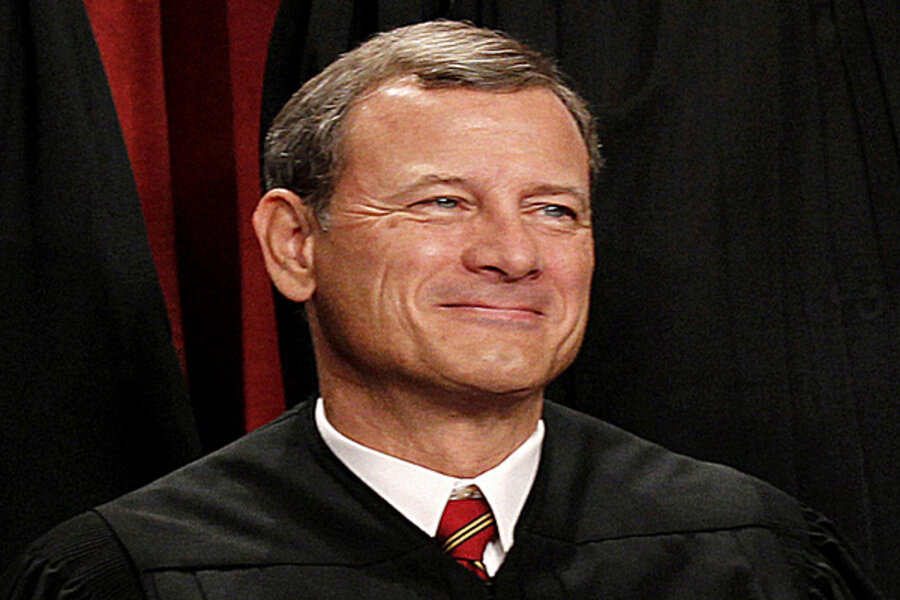How John Roberts upheld health-care law while limiting congressional power
Loading...
| Washington
In upholding President Obama’s health-care reform law, the US Supreme Court once again split the difference, attempting to offer a bit of something for everyone.
For supporters of the Patient Protection and Affordable Care Act, the entire law survived (by a slim 5-to-4 vote) what has been a bruising election-year debate over the statute’s legality and propriety.
It is a resounding victory for Mr. Obama, affirming the constitutionality of the signature legislative achievement of his tenure in the White House.
But Thursday’s ruling also included an important victory for Republicans and other critics of the health-care reform law, who complained that Congress, in ordering every American to buy a government-approved level of health insurance or pay a penalty, had overstepped its authority under the Commerce Clause.
The high court sided 5 to 4 with that position.
At the center of this Solomon-like judicial maneuver was Chief Justice John Roberts, whose fancy footwork provided the decisive fifth vote on both sides of the dispute.
In the end, Chief Justice Roberts declared that even though Congress could not enact the Affordable Care Act (ACA) under the Commerce Clause, it nonetheless retained the power to do so under its authority to raise and collect taxes.
“The court today holds that our Constitution protects us from federal regulation under the Commerce Clause so long as we abstain from the regulated activity,” he wrote. “But from its creation, the Constitution has made no such promise with respect to taxes.”
In effect, Roberts and four members of the court’s liberal wing ruled that what Congress called a “penalty” in the ACA was really a “tax.”
The distinction is huge. It means that Congress intended the payment as an incentive for Americans to buy health insurance, not as punishment for those who failed to obey the federal command.
While Congress had never before tried to use its Commerce Clause power to compel Americans to buy a product they did not wish to purchase, there is nothing new about Congress using taxes or tax credits to encourage Americans to buy something they may not want.
“Sustaining the mandate as a tax depends only on whether Congress has properly exercised its taxing power to encourage purchasing health insurance, not whether it can,” Roberts wrote.
“Upholding the individual mandate under the Taxing Clause thus does not recognize any new federal power,” he said.
Power was the whole point of the legal challenge to the health-care reform law.
Critics had warned that the so-called individual mandate, if upheld, would grant limitless authority to the national government to regulate every aspect of American life. There was even talk of a dreaded broccoli mandate.
Roberts answered that concern by declaring the Commerce Clause authorized the regulation of economic activities but did not reach inactivity – like the decision not to buy health insurance.
“The Framers gave Congress the power to regulate commerce, not to compel it, and for over 200 years both our decisions and Congress’s actions have reflected this understanding,” he said. “There is no reason to depart from that understanding now.”
The chief justice’s actions in the case were all about finding middle ground to maintain the status quo.
By positioning himself between the high court’s liberal wing and conservative wing, Roberts denied a fifth and decisive vote to the court’s conservatives who were poised to strike down the entire health-care law, not just the mandate.
It would have been a conservative constitutional landmark and perhaps the most significant assertion of judicial authority by the Supreme Court to police the federal-state balance of power since the New Deal in the 1930s.
It also would have set off a powder keg of partisan criticism of the high court for ruling so decisively against the president in an election year and for establishing firm limits on national power.
Instead, Roberts’s actions have managed to spare the court – and the chief justice himself – from becoming any more of a political target in the current election season.
Liberals praised the high court’s actions, and celebrated the survival of the besieged health-care law.
“Today the court affirmed its role as the neutral arbiter of the law for all Americans,” said Neera Tanden, president of the Center for American Progress.
Many conservatives expressed disappointment, with some saying the outcome of the case raises questions about Roberts’s commitment to what was called the “federalism revolution” at the Supreme Court under former Chief Justice William Rehnquist.
“The court’s decision is alarming and deeply wrong,” said Steven Aden of the Alliance Defense Fund.
Others, however, saw Roberts’s maneuvers as offering a silver lining.
Richard Garnett, a law professor at Notre Dame and a former Rehnquist clerk, said it was “highly significant” that the court had retained a role in policing the boundaries of federal power. He said the action was “in keeping with the Rehnquist Court’s emphasis on federalism.”
Georgetown Law Professor Randy Barnett suggests it would be a mistake to view Thursday’s decision as a death knell for federalism.
“The Founders’ scheme of limited and enumerated powers has survived to fight another day,” he wrote on SCOTUSBLOG.
Others, still, were less impressed with the Solomonic maneuver.
“Today’s closely divided decision shows that the Supreme Court takes the need for constitutional limits on federal power seriously, but not seriously enough,” said Ilya Somin, a law professor at George Mason University.
“Chief Justice Roberts’ opinion correctly recognizes that the Commerce Clause does not allow Congress to force people to purchase products they don’t want,” he said. “The problem is that he then allows Congress to impose almost any mandate it wants so long as it is structured as a so-called ‘tax.’ ”







